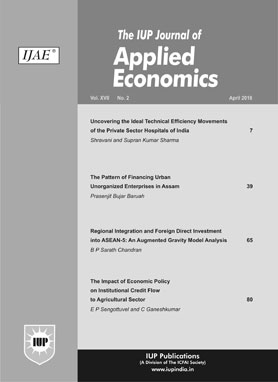
Jan' 23
The IUP Journal of Applied Economics
| Article | Price (₹) | ||
| Causality Between Green Entrepreneurship and Sustainable Development: A Cross-Country Analysis Using ARDL Model |
100
|
||
| Effect of Green Bond Issuance on Stock Returns of Indian Public Companies |
100
|
||
| Role of Pre-Money Valuation Determinants of Indian Startups in Fundraising and Predicting Unicorns |
100
|
||
Causality Between Green Entrepreneurship and Sustainable Development: A Cross-Country Analysis Using ARDL Model
The study examines the causal relationship between Green Entrepreneurship Ecosystem (GEE) and Sustainable Development (SD) and its key drivers in the short and long term using ARDL model. It uses Global Sustainable Development Index (GSDI), Economic Development Index (EDI), Social Development Index (SDI), Environmental Sustainability Index (ESI) and Green Entrepreneurship Ecosystem Index (GEEI) as proxy variables for social, economic, social and environmental development, and GEE, respectively in a simultaneous set of regression equations. GSDI, EDI, SDI, ESI and GEEI related data were used for 34 countries for the period 2000-2019. The empirical findings reveal that GEE would be useful to boost social, economic and environmental development in the long term. The impact of GEE on social and economic development was negative in the short run, while environmental development would be positive in enhancing economic and social development, and GEE in the long term. The Granger causality test was also used to check the cointegration, and short- and long-term causality of explanatory variables with respective dependent variables, and the results are presented.
Effect of Green Bond Issuance on Stock Returns of Indian Public Companies
The size of green bond market has been increasing rapidly since the Paris Agreement on climate change was adopted in 2015. This paper is an empirical study on the public companies that have financed greenfield projects through green bonds. The study is based on equity investor behavior following the news announcement of green bonds. An event study approach is applied to find out the impact on abnormal returns of stocks during the window period of the announcement day. The study supports that stock return behavior is positive, which is an indication that investors responded positively to the announcement of green bonds. Leverage analysis is also performed, and it is found that the financial leverage increased in the post-issue period of green bonds. It is an indication that the use of low-cost security in financing the greenfield projects is capable of maximizing shareholder returns, if the return on investment is more than the cost of green bonds. This paper adds to the existing literature as it focuses on the stock performance of public companies around green bond issuance announcement. Further, the analysis of financial leverage of the firms distinguishes this study from others.
Role of Pre-Money Valuation Determinants of Indian Startups in Fundraising and Predicting Unicorns
The study intends to analyze the role of pre-money valuation determinants in the valuation of startups and in predicting unicorns. Secondary data was collected from Indian startups of different sizes-decacorns, unicorns, early-stage startups, minicorns and soonicorns. The initial sample consisted of 3,342 completed deals between 2010 and 2022. In addition, 9 independent variables representing firm characteristics and funding determinants were considered, with pre-money valuation as the dependent variable. Multiple regression and binary logistic regression were applied to predict the value of 9 determinants and compare the pre-money valuation of the two groups, unicorns/decacorns with early-stage/minicorn/soonicorn, respectively. The results from multiple regression highlighted that the variables such as total funding raised to date, funding type/series, annual revenue, funding round, latest funded amount, and stake acquired have a significant impact on the pre-money valuation of Indian startups. The results of binary logistic regression also highlighted that the unicorn/decacorn group had raised higher total funding in a short period than the other group.